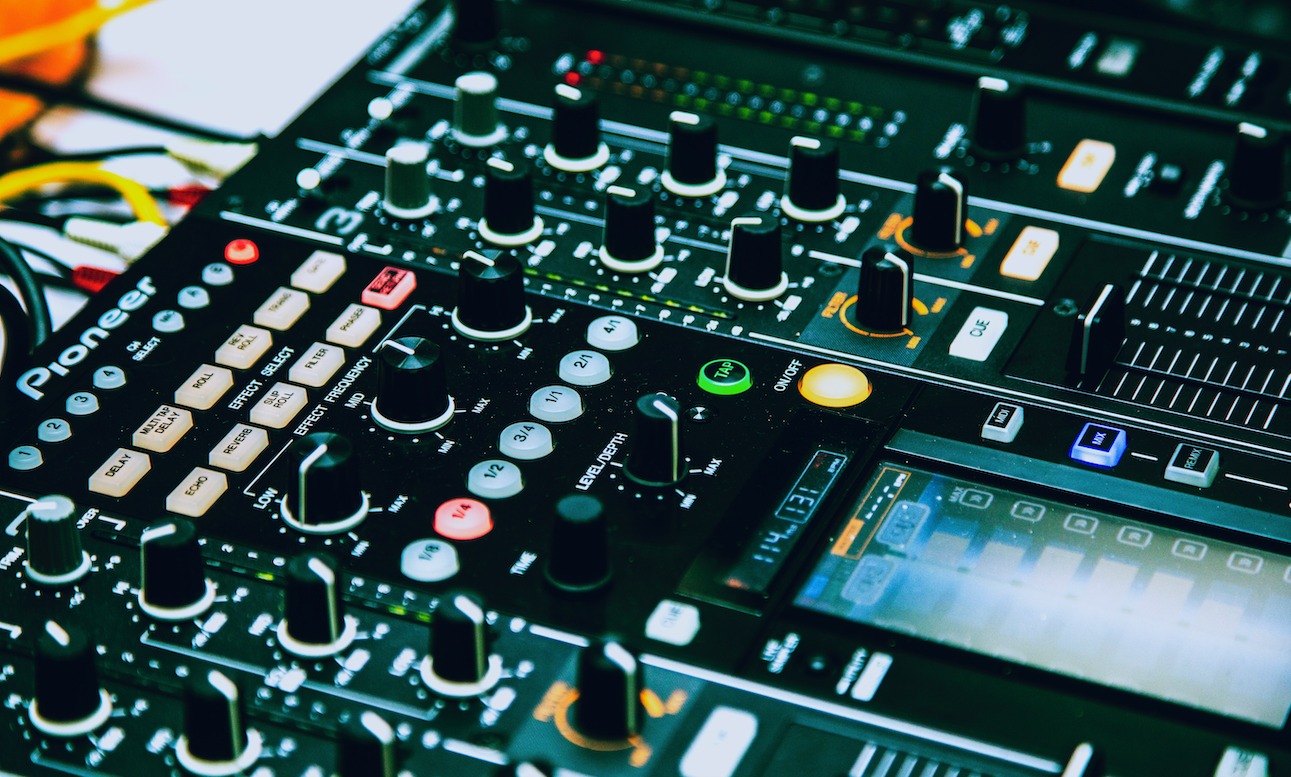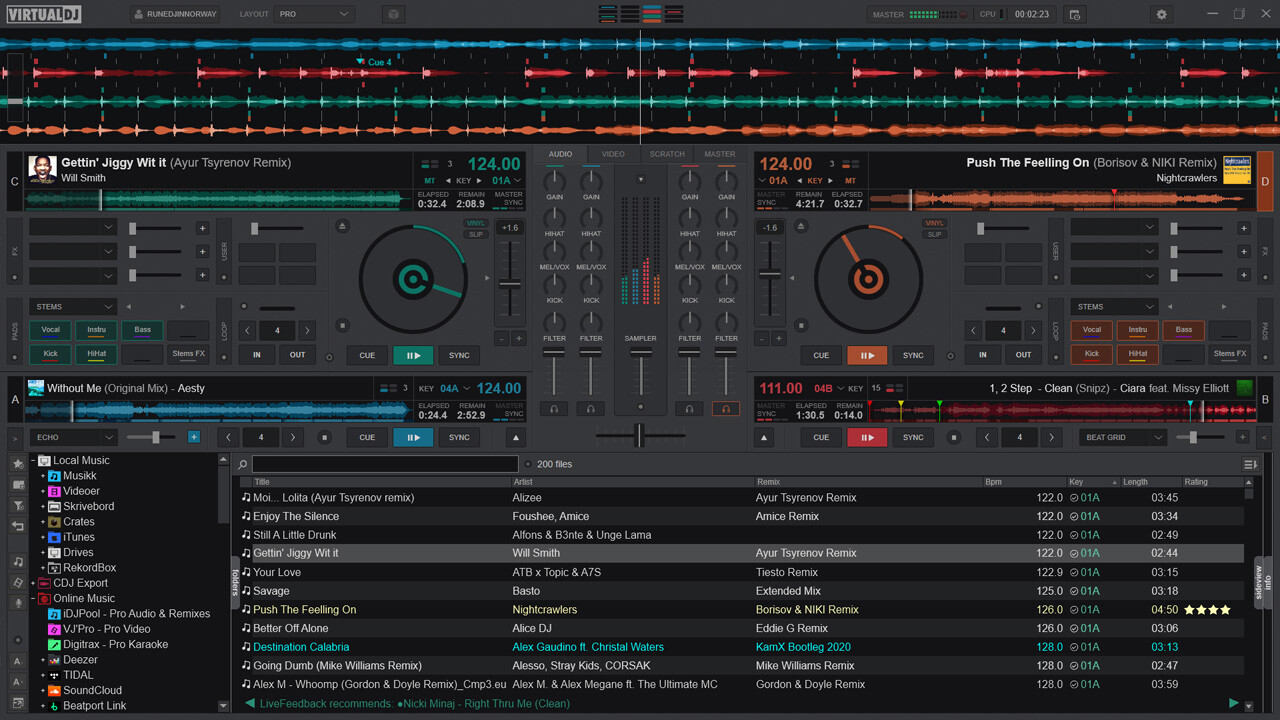Home>Events & Info>Acapella>How To Mix Acapella Tracks In Live DJ Set


Acapella
How To Mix Acapella Tracks In Live DJ Set
Modified: March 4, 2024
Learn how to seamlessly integrate acapella tracks into your live DJ sets with our step-by-step guide. Elevate your mixes and create unique musical experiences.
(Many of the links in this article redirect to a specific reviewed product. Your purchase of these products through affiliate links helps to generate commission for AudioLover.com, at no extra cost. Learn more)
Table of Contents
Introduction
Are you a DJ looking to take your live sets to the next level? Acapella tracks can be the secret weapon to elevate your mixes and create a unique experience for your audience. Acapella, derived from the Italian phrase “a cappella” meaning “in the manner of the chapel,” refers to vocal music without instrumental accompaniment.
When incorporated effectively, acapella tracks can inject energy, dynamics, and a fresh perspective into your DJ performance. Mixing acapellas in a live set requires careful consideration and technique, but the results can be incredibly rewarding.
In this article, we will explore the art of mixing acapella tracks in a live DJ set. We will cover the fundamentals of understanding acapella tracks, selecting compatible acapellas, adjusting tempo and key, beatmatching, EQing, applying effects, mixing acapellas with instrumental tracks, and transition techniques. Whether you’re a seasoned DJ or just starting out, this guide will provide you with the knowledge and techniques to confidently incorporate acapella tracks into your live performances.
Before we dive into the specifics, it’s important to note that while acapella tracks can certainly enhance your sets, using them sparingly and strategically is key. Overusing acapellas or not blending them seamlessly with other tracks can disrupt the flow and energy of your set. Remember, moderation and thoughtful selection are crucial for a successful mix.
Now, let’s embark on this acapella adventure and discover the exciting world of mixing acapella tracks in a live DJ set!
Understanding Acapella Tracks
Before diving into the mixing techniques, it is important to have a solid understanding of what acapella tracks are and how they differ from regular songs. Acapella tracks are essentially vocal-only versions of songs, stripped of any accompanying instrumentals. These tracks showcase the raw vocal talent of the artist and are often used by DJs to add a unique twist to their mixes.
One of the main benefits of using acapella tracks is the ability to create interesting mashups and remixes. By layering acapellas on top of instrumental tracks, DJs can produce a fresh and exciting sound that adds a new dimension to the original songs.
When selecting acapella tracks, it is important to consider the key and tempo compatibility with your existing tracks. This ensures that the acapella blends seamlessly with the other elements of your mix. It is helpful to have a good ear for pitch and tempo to accurately identify the key and tempo of acapella tracks.
In terms of genre, acapella tracks cover a wide range of musical styles, including pop, hip-hop, EDM, and more. This diversity allows DJs to incorporate acapellas into various genres and experiment with different sounds and moods.
Additionally, acapella tracks often come in isolated stems, which means that each vocal track is separated into individual files, such as lead vocals, harmonies, ad-libs, and background vocals. This provides DJs with the freedom to manipulate and re-arrange the vocal elements to fit their creative vision.
While acapella tracks certainly provide creative opportunities, it is important to be considerate of copyright laws and usage rights. Make sure to obtain the necessary licenses or use acapella tracks from reputable sources that provide royalty-free samples.
Now that we have a clear understanding of what acapella tracks are and their potential applications, let’s move on to the next section, which will guide you through the process of selecting compatible acapella tracks for your DJ sets.
Selecting Compatible Acapella Tracks
When it comes to mixing acapella tracks in a live DJ set, selecting compatible acapellas is essential to ensure a smooth and cohesive mix. Here are a few key factors to consider when choosing acapella tracks:
- Genre: Start by identifying the genre of your set or the style of music you typically play. Find acapella tracks that align with that genre to maintain consistency and coherence throughout your mix.
- Key and Tempo Compatibility: Pay attention to the key and tempo of your existing tracks. Look for acapella tracks that match or closely align with the key and tempo of your mix. This will make blending the vocals with the instrumental tracks much smoother.
- Lyrics: Consider the lyrics of the acapella tracks you choose. Look for vocal samples that contain lyrics that resonate with the mood or theme of your set. This can add an extra layer of depth and meaning to your mix.
- Quality: Opt for high-quality acapella tracks to ensure they sound clean and professional in your mix. Look for acapellas that have been properly isolated and are free from background noise or other unwanted artifacts.
- Variety: Don’t be afraid to experiment with different vocal styles and tones. Mix it up by incorporating acapellas with different vocal ranges, from deep and soulful to high-pitched and energetic. This adds variety and keeps your mix interesting.
What if you can’t find an exact match for the key or tempo of your instrumental tracks? Don’t worry! There are tools and techniques available to adjust the key and tempo of acapella tracks to make them compatible. We will explore these techniques in more detail in the following sections.
Lastly, keep in mind that the overall flow and vibe of your set should guide your acapella selection process. Trust your musical instincts and choose acapellas that enhance the energy and atmosphere you want to create.
Now that you know how to select compatible acapella tracks, let’s move on to the next section, where we will discuss adjusting the tempo and key of the acapella tracks to fit seamlessly into your mix.
Adjusting Tempo and Key
When working with acapella tracks in a live DJ set, it is common to encounter situations where the tempo or key of the acapella doesn’t match the rest of your mix. Fortunately, there are techniques and tools available to adjust the tempo and key of acapella tracks to ensure a harmonious blend with the other tracks in your set.
1. Adjusting Tempo: To match the tempo of the acapella track with your mix, you can use software or DJ tools that allow for tempo adjustment. Most DJ software provides a tempo control feature that enables you to increase or decrease the BPM (beats per minute) of the acapella track. Gradually adjust the tempo until it aligns with the other tracks in your mix. Be cautious not to change the tempo too drastically, as it may affect the natural flow and feel of the acapella.
2. Adjusting Key: If the key of the acapella doesn’t match the rest of your mix, you can transpose it using pitch-shifting techniques. DJ software often includes a pitch adjuster that allows you to raise or lower the pitch of the acapella track to match the key of the other tracks. Experiment with small adjustments until you find the right balance and harmony between the acapella vocals and the instrumental tracks.
When adjusting the tempo or key of an acapella track, it’s important to listen carefully and trust your ears. Pay attention to how the vocals blend with the rest of the mix. If the adjustments start to impact the sound quality or create unnatural artifacts, consider finding a different acapella track that better fits the desired tempo and key.
Remember, the goal is to seamlessly integrate the acapella into your mix, creating a cohesive and enjoyable listening experience for your audience. Putting in the effort to adjust the tempo and key properly will greatly contribute to the overall success of your acapella mix.
Now that you understand how to adjust the tempo and key of acapella tracks, let’s move on to the next section, where we will explore the technique of beatmatching acapella tracks to ensure a smooth transition in your DJ set.
Beatmatching Acapella Tracks
Beatmatching is a fundamental skill for DJs, and it becomes even more crucial when working with acapella tracks in a live set. Beatmatching involves synchronizing the beats of two or more tracks to ensure a seamless transition and maintain a consistent rhythm throughout your mix. Here’s how you can beatmatch acapella tracks:
1. Analyze the BPM: Before attempting to beatmatch, analyze the BPM (beats per minute) of both the acapella track and the track it will be mixed with. Most DJ software provides BPM analysis tools to make this process easier. Ensure that the BPM values are displayed accurately for both tracks.
2. Align the Beats: Start by aligning the beats of the acapella track and the instrumental track manually. Listen closely and identify the strong, steady beats in both tracks. Use the waveform display on your DJ software to visually align the beats if needed.
3. Adjust Pitch or Tempo: If the beats don’t align perfectly, make small adjustments to the pitch or tempo of the acapella track to match the beats of the instrumental track. Use the pitch control or tempo adjustment feature in your DJ software to fine-tune the alignment.
4. Use Cue Points: Set cue points at key sections of the acapella track, such as the start of a verse or chorus. These cue points will help you prepare and time your transitions effectively, allowing you to seamlessly mix the acapella into the instrumental track.
5. Blend the Beats: Once the beats are aligned and the tracks are in sync, gradually bring up the volume of the acapella track while reducing the volume of the instrumental track. Use the EQ controls to adjust the frequency ranges and ensure a smooth and balanced transition between the tracks.
With practice, you’ll become more proficient at beatmatching acapella tracks and creating seamless transitions in your DJ sets. When done correctly, beatmatching acapellas can inject energy and excitement into your mixes and captivate your audience.
Now that you’ve learned how to beatmatch acapella tracks, let’s move on to the next section, where we’ll explore the technique of EQing acapella tracks to enhance their clarity and blend them seamlessly with your mix.
EQing Acapella Tracks
EQing (equalizing) acapella tracks is a crucial step in the mixing process to ensure that the vocals sit well in your DJ set and blend seamlessly with the other tracks. By adjusting the frequency balance of the acapella, you can enhance its clarity and prevent it from clashing with other elements of your mix. Here are some key tips for EQing acapella tracks:
1. Cut Unwanted Frequencies: Begin by identifying any unwanted frequencies in the acapella track. Use a high-pass filter or low-cut EQ to remove unnecessary low-end rumble or sub-bass frequencies that can muddy the mix. This frees up space for the other elements and keeps the vocals focused and clear.
2. Enhance Presence: Boosting the upper midrange frequencies (around 2 kHz to 5 kHz) can add presence and intelligibility to the acapella vocals. This can help the vocals cut through the mix and be heard more prominently.
3. De-Essing: Address any harsh or sibilant “s” or “t” sounds by applying a de-esser. A de-esser is a specialized EQ tool that reduces excessive sibilance without affecting the rest of the vocal frequencies.
4. Space and Depth: To create a sense of depth and space, consider adding a touch of reverb or delay to the acapella vocals. Be cautious not to overdo it, as too much reverb or delay can make the vocals sound distant or washed out.
5. Tonal Balance: Pay attention to the overall tonal balance of the acapella. Use your EQ controls to adjust the levels of the bass, midrange, and treble frequencies to ensure that the vocals integrate smoothly with the other tracks in your mix.
Remember, every acapella track is unique, and the EQ adjustments required may vary depending on the original recording and mixing quality. Trust your ears and monitor the acapella within the context of your mix to make precise EQ decisions.
By applying these EQ techniques to your acapella tracks, you can bring out the best qualities of the vocals, improve their clarity, and seamlessly integrate them into your DJ set. EQing is a powerful tool in the hands of a skilled DJ and can greatly elevate the impact of your mix.
Now that you’ve learned how to EQ acapella tracks, let’s move on to the next section, where we’ll explore the process of applying effects to enhance the creativity and atmosphere of your acapella mixes.
Applying Effects to Acapella Tracks
Applying effects to acapella tracks can add unique textures, creativity, and enhance the overall atmosphere of your DJ set. Effects allow you to manipulate and transform the vocals, creating different moods and intensifying the impact of the acapella. Here are some popular effects and techniques to consider when working with acapella tracks:
1. Reverb: Adding reverb to acapella vocals can create a sense of space and depth. Experiment with different reverb settings to find the right balance between a subtle, natural ambience and a larger, more ethereal sound.
2. Delay: Applying delay to acapella tracks can introduce rhythmic patterns and echoes, adding a unique flavor to the vocals. Adjusting the delay time and feedback settings can create interesting textures and atmospheric effects.
3. Chorus/Flanger: Chorus and flanger effects can add a sense of movement and modulation to acapella vocals. These effects create a thickening or sweeping sound, enhancing the vocal presence and filling out the stereo image.
4. Pitch Shifting/Harmonization: Experiment with pitch-shifting or harmonization effects to create interesting vocal harmonies or produce unique, otherworldly sounds. These effects can add depth and complexity to your mix, enhancing the overall musicality.
5. Filtering: Use filters to shape the frequency response of the acapella tracks. High-pass and low-pass filters can accentuate certain frequency ranges or create dramatic filter sweeps for added impact and variation.
6. Distortion/Overdrive: Applying distortion or overdrive effects to acapella vocals can add grit, aggression, or intensity. Use these effects sparingly and tastefully to maintain clarity and intelligibility while adding an edge to the vocals.
Remember, the goal is to enhance the acapella tracks and complement the mood and energy of your DJ set. Experiment with different effects, but always ensure that the vocals remain intelligible and don’t overpower the rest of the mix.
When applying effects to acapella tracks, it’s a good idea to use send/return channels in your DJ software or mixer. This allows you to apply effects to multiple tracks simultaneously and maintain consistent levels and balance between the acapella and other elements of your mix.
By incorporating effects and utilizing the endless possibilities they offer, you can create captivating and dynamic acapella mixes that engage your audience and set your DJ sets apart.
Now that you’ve learned about applying effects to acapella tracks, let’s move on to the next section, where we’ll explore techniques for mixing acapella tracks with instrumental tracks for seamless transitions in your DJ sets.
Mixing Acapella Tracks with Instrumental Tracks
One of the key challenges when working with acapella tracks in a live DJ set is seamlessly mixing them with instrumental tracks. A smooth transition between the acapella and the instrumental elements is essential to maintain the flow and energy of your mix. Here are some techniques to help you blend acapella tracks with instrumental tracks:
1. Phrase Matching: Identify the phrasing and structure of both the acapella and the instrumental track. Look for natural points of transition, such as the end of a chorus or verse, and use them as reference points to align the tracks. This ensures that the acapella vocals and instrumental elements change together, creating a cohesive transition.
2. EQ and Mixing: Adjust the EQ levels of both the acapella and instrumental tracks to ensure they sit well together in the mix. Use EQ to carve out space for each element, allowing the vocals to shine while still maintaining a balanced overall sound.
3. Volume Control: Gradually increase the volume of the acapella track while simultaneously decreasing the volume of the instrumental track. This gradual fade-in/fade-out technique creates a smooth transition, avoiding sudden changes that can disrupt the flow of your mix.
4. Effects: As mentioned in the previous section, applying effects to the acapella or instrumental tracks can help enhance the transition. Consider using effects like filtering, reverb, or delay to create interesting and seamless blends between the two elements.
5. Looping: Looping a section of the instrumental track and layering the acapella vocals on top can create an exciting build-up or breakdown. Experiment with looping different parts and aligning them with the acapella vocals to add a unique twist to your mix.
6. Syncopation and Rhythm: Explore rhythmic elements within the acapella and instrumental tracks that complement each other. Syncopating vocals with instrumental percussion elements or layering vocals over rhythmic instrumental sections can create a cohesive and engaging mix.
Remember, the goal is to create a seamless fusion between the acapella and instrumental tracks, so the transition feels natural and effortless to your audience. Practice and experimentation are key to mastering these mixing techniques and finding your own unique style.
Now that you have a better understanding of mixing acapella tracks with instrumental tracks, let’s move on to the next section, where we’ll explore transition techniques specifically tailored for acapella tracks.
Transition Techniques for Acapella Tracks
When working with acapella tracks in a live DJ set, it’s important to master transition techniques that specifically highlight and showcase the vocals. Smoothly transitioning between acapella tracks can maintain the energy and captivate your audience. Here are some transition techniques to consider:
1. Acapella Drops: Create a dramatic build-up by gradually reducing the volume of the instrumental track while highlighting the acapella vocals. This can be done by using filter sweeps, volume automation, or using a mixer’s crossfader to smoothly emphasize the vocals. Once the instrumental drops out, bring in the next track seamlessly for a powerful transition.
2. Mashups and Remixes: Utilize the creative potential of acapella tracks by layering them over instrumental sections of other songs. Experiment with blending elements from multiple tracks, creating unique mashups or remixes that surprise and engage your audience.
3. Acapella Loops and Acapella Only Breaks: Looping a specific section or vocal hook of the acapella track can create a catchy and engaging transition point. Alternatively, featuring an acapella-only break, where the instrumental drops out entirely, can bring focus to the vocals and create a dynamic moment in your DJ set.
4. Key Matching: If you have multiple acapella tracks in your set, consider transitioning between them by key matching. Find acapella tracks with compatible keys, and mix them with instrumental tracks in similar or relative keys to maintain harmonic coherence and a smooth transition.
5. Reverb and Delay Trails: Use the natural decay of reverb or delay effects to create smooth transitions. As the instrumental track gradually fades out, let the acapella vocals trail off with a subtle reverb or delay effect. This technique helps blend the acapella with the upcoming track, giving a cohesive and seamless transition.
6. Phrasing and Beat Sync: Pay attention to the structure and phrasing of both the acapella and instrumental tracks. Look for complementary sections with similar rhythms or melodic elements and mix them at appropriate points to maintain a coherent flow. This technique helps maintain the groove and rhythm of your DJ set.
Remember, the transition techniques you choose should depend on the mood and energy you want to convey in your mix. Experiment with different techniques and trust your instincts to create seamless transitions that enhance the impact of the acapella tracks.
Now that you have a range of transition techniques, you can confidently incorporate acapella tracks into your DJ sets to create memorable and exciting performances.
Concluding our exploration of transition techniques, let’s move on to the final section, where we’ll summarize our key points and conclude our guide to mixing acapella tracks in live DJ sets.
Conclusion
Congratulations! You’ve reached the end of our comprehensive guide on mixing acapella tracks in live DJ sets. By understanding the fundamentals, selecting appropriate acapella tracks, adjusting tempo and key, beatmatching, EQing, applying effects, blending with instrumentals, and utilizing transition techniques, you now have a toolbox of skills to create captivating and seamless acapella mixes.
Remember, the key to successful acapella mixing is thoughtful selection, careful execution, and creative experimentation. Pay attention to the genre, key, and tempo compatibility when selecting acapella tracks and strive for a harmonious blend with your instrumental tracks. Utilize tools and techniques to adjust tempo and key, and apply EQing to enhance clarity and balance. Don’t be afraid to experiment with effects to add depth and texture to the vocals, but always ensure the vocals remain intelligible and balanced within the mix.
When it comes to transitions, techniques such as acapella drops, mashups, loops, and key matching are your allies. These techniques help maintain the energy and intrigue of your mix while showcasing the unique qualities of the acapella tracks.
As with any skill, practice is crucial to mastering the art of mixing acapella tracks. Take the time to experiment, refine your techniques, and develop your own unique style. With dedication and creativity, you can create memorable DJ sets that leave a lasting impression on your audience.
Remember, moderation is key when incorporating acapella tracks into your mixes. Use them strategically and sparingly to maximize their impact. The goal is to create a balanced mix that showcases the acapella tracks while maintaining the overall flow and energy of your set.
We hope this guide has provided you with valuable insights and techniques to enhance your DJ performances. Embrace the world of acapella tracks, let your creativity soar, and take your live sets to new heights.
Now, armed with your newfound knowledge, go forth and rock the dancefloor with your skillful acapella mixes!










